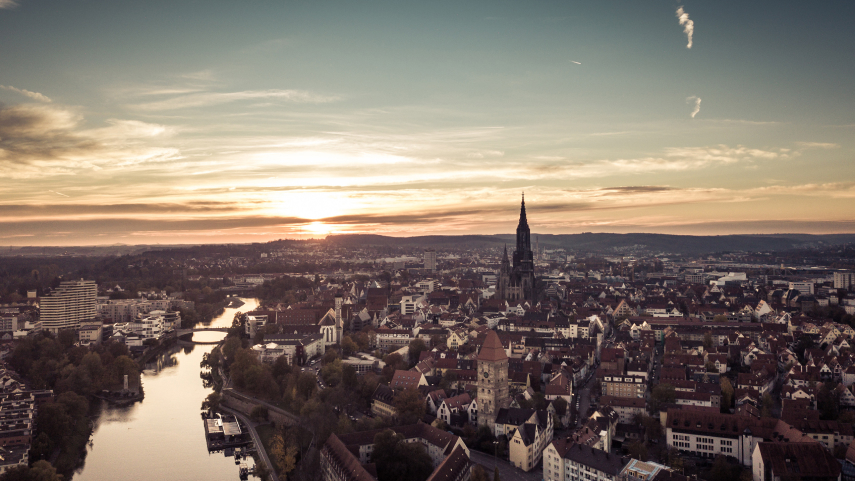Spitzenleistungen
aus Unternehmen der Region.
Mitglieder
Mitglieder der
Innovationsregion Ulm
Mehr als 100 Mitglieder identifizieren sich mit der Innovationsregion als aktive Mitgestalter und überzeugte Botschafter der herausragenden Standortqualitäten. Rund ein Drittel der Mitglieder stammt aus dem Verwaltungs- und Bildungsbereich, etwa zwei Drittel aus der Wirtschaft, vom Bankinstitut über das mittelständische Unternehmen bis hin zum Weltkonzern.
| Unternehmen | Branche | Standorte | Mitarbeiter | Kontakt | Link | |
|---|---|---|---|---|---|---|

|
ACP IT Solutions GmbH | Informationstechnologie | Neu-Ulm, Ulm | 20 | info.ulm@acp.de | zur Website |

|
ADK GmbH für Gesundheit und Soziales | Gesundheitswesen | Ehingen | ca. 2400 | info@adk-gmbh.de | zur Website |
|
|
Alb-Donau-Kreis | Verwaltung | Ehingen, Langenau, Ulm | 900 | info@alb-donau-kreis.de | zur Website |
   |
allgaier GmbH | Logistik, Transport | Neu-Ulm | 600 | info@allgaier.com | zur Website |
   |
AOK- Die Gesundheitskasse Ulm-Biberach | Gesundheitswesen | Ulm | 570 | info@adk-gmbh.de | zur Website |
   |
AXION AG | Automobil & Fahrzeugbau | Weißenhorn | 23 | info@axionag.de | zur Website |
   |
Baden-Württembergische Bank | Finanzdienstleister | Ulm | 10000 | info@bw-bank.de | zur Website |
   |
BED Businesspark Ehingen Donau GmbH | Dienstleistung | Ehingen | 4 | mail@businesspark-ehingen.de | zur Website |
   |
Beurer GmbH | Gesundheitswesen | Ulm | knapp 2000 weltweit | vertrieb@beurer.de | zur Website |
   |
BITE GmbH | IT & Software | Ulm | info@b-ite.de | zur Website | |
   |
Brauerei Gold Ochsen GmbH | Brauerei | Ulm | 200 | info@goldochsen.de | zur Website |
   |
braun-steine GmbH | Baugewerbe | 110 | info@braun-steine.de | zur Website | |
Wirtschaft
Stark aufgestellt in der Innovations-
region Ulm
Stark aufgestellt ist die Wirtschaft in der Innovationsregion Ulm. Ein ausgeglichener Branchenmix sorgt für Krisensicherheit. Die hohe Wirtschaftskraft der Region zeigt sich in Top-Platzierungen bei zahlreichen Studien und Rankings. In vielen Bereichen zählt sie zu den führenden Regionen Deutschlands. Internationale Key-Player bestimmen maßgeblich die Kernkompetenzen der Innovationsregion, ihre technologische Wettbewerbsfähigkeit und die internationale Ausrichtung.


Weltweit agierende Firmen mit Präsenz in der Region
Neben den Großkonzernen bilden die mittelständischen und weitgehend familiengeführten Unternehmen das wirtschaftliche Rückgrat der Region und tragen maßgeblich zur Beschäftigung, Steuerkraft und Standortsicherung bei.
Wertvolle Kooperationen
Digitalisierungszentrum
Das Digitalisierungszentrum (Digital Hub) Ulm, Alb-Donau, Biberach ist die erste Anlaufstelle für Händler, Industrieunternehmen, Handwerksbetriebe und Dienstleister, die Fragen zur Digitalisierung haben.Das Digitalisierungszentrum Ulm, Alb-Donau, Biberach stellt hierfür sowohl technische Infrastruktur als auch Fachwissen zur Verfügung, um die Erprobung und Entwicklung neuer digitaler Lösungen, Produkte und Geschäftsmodelle für Unternehmen aller Branchen zu fördern. Dazu gehören unter anderem Experimentierräume, Informationsräume und Coworking Spaces.
Für eine schnelle und bequeme Erreichbarkeit gibt es mehrere Standorte in der Region Ulm, Alb-Donau und Biberach. Neben der Zentrale in Ulm stehen auch Anlaufstellen in Ehingen, Riedlingen, Laupheim und Amstetten sowie ein Kompetenzzentrum für Building Information Modeling an der Hochschule Biberach zur Verfügung. Durch Serviceleistungen wie Beratungen, Veranstaltungen wird insbesondere kleineren und mittleren Unternehmen in der Region der Zugang zu neuen Technologien erheblich erleichtert.
KI Campus Ulm (KICU)
KICU – Raum für KI-Pioniere und Visionäre
Der KI Campus Ulm (KICU) – ein Projekt der PEG Ulm mbH – ist ein dynamischer Hub für KI-Engagement, der auf über 1.000 qm Coworking Spaces, Arbeitsbereiche und Präsentationsflächen bietet. Als Inkubator fördert er Synergien und den Wissensaustausch zwischen den unterschiedlichsten Akteuren, um KI-Technologien und Ideen voranzutreiben. Es ist ein inspirierender Ort, an dem Ideen auf Realität treffen und Kooperationen zwischen Forschung und Industrie entstehen, unterstützt durch eine Infrastruktur, die zur Vernetzung einlädt und den Dialog zwischen Wissenschaft und Wirtschaft fördert. Das KICU ist offen für unterschiedlichste Themen und Aktivitäten, die das Thema KI begleiten.
KICU als Katalysator für KI-Community und Synergien
Die Infrastruktur des KICU bietet optimale Bedingungen für eine prosperierende regionale KI-Community, die Innovation vorantreibt und den Standort im globalen Technologiewettbewerb stärkt. Die Bereitstellung von Co-Working-Räumen, Veranstaltungsräumen und Open-Spaces in Ulm fördert die Bildung einer lebendigen KI-Community. Sie unterstützt die Vernetzung von Wissensträgern, erleichtert den Zugang zu neuen Technologien und schafft eine Plattform für den Austausch und das Pooling von Ressourcen. Dadurch können sowohl Einzelakteure als auch die gesamte Gemeinschaft von den optimalen Voraussetzungen zur Zusammenarbeit, gesteigerter Sichtbarkeit und inspirierendem Innovationsklima profitieren. Dies stärkt Ulm als einen zentralen Knotenpunkt für KI-Expertise und zieht Talente, Investitionen sowie neue Geschäftsmodelle an. Werden Sie Teil der Community!
Cluster in der
Innovationsregion ulm
In der Innovationsregion Ulm gibt es drei Cluster: Der BioPharma Cluster South Germany, der Cluster Nutzfahrzeuge Schwaben sowie der Logistik-Cluster Schwaben.
„Cluster“ sind geografische Ansammlungen von Unternehmen, Institutionen und Organisationen aus ähnlichen oder verwandten Branchen, die eng miteinander vernetzt sind. Durch ihre Nähe und Zusammenarbeit profitieren die Cluster-Mitglieder von Wissenstransfer, gemeinsamen Innovationen und effizienteren Prozessen. Sie fördern die Wettbewerbsfähigkeit und stärken die regionale Wirtschaft, indem sie Synergien nutzen und Ressourcen teilen.
Biopharma Cluster
Der BioPharma Cluster South Germany ist einer der wichtigsten europäischen Produktionsstandorte der europaweit zugelassenen biopharmazeutischen Wirkstoffe. Die Region zwischen Ulm und Bodensee zählt zu den umsatzstärksten und bedeutendsten Forschungs-, Entwicklungs- und Produktionsstandorten der pharmazeutischen Industrie in Deutschland.
Der Cluster entwickelt vor Ort therapeutische oder diagnostische Verfahren und forscht auf dem Gebiet der personalisierten Medizin.
So leistet er einen einzigartigen Beitrag zur Medizin der Zukunft.
Ein exzellentes Life-Science-Profil macht den BioPharma Cluster South Germany zum Top-Standort biopharmazeutischer Entwicklung und Produktion. Herausragende Forschungseinrichtungen, vielfältige Kooperationsprojekte – der BioPharma Cluster bietet optimale Voraussetzungen für wegweisende Grundlagenforschung.
Nutzfahrzeuge Cluster
Die Innovationsregion Ulm ist Deutschlands Nutzfahrzeugstandort Nummer eins. Hier findet sich bundesweit die höchste Konzentration an Nutzfahrzeugherstellern. Dies führte im Jahr 2007 zur Gründung der Initiative „Cluster Nutzfahrzeuge Schwaben“. Zahlreiche Mitgliedsunternehmen decken die gesamte Wertschöpfungskette im Nutzfahrzeugbau ab. Als Ziele sind die Vernetzung der Mitgliedsfirmen und der Austausch mit Wissenschaft und Forschungseinrichtungen definiert. Durch die gemeinsame Bearbeitung zukunftsorientierter Projekte sollen dauerhafte Wettbewerbsvorteile für die Beteiligten, aber auch für die Region insgesamt erzielt werden.
Logistik Cluster
Die Logistik hat eine zentrale Querschnittsaufgabe, die allen Unternehmen zugutekommt und für die gesamte Wirtschaft von entscheidender Bedeutung ist. Nahezu alle Unternehmen aus den Bereichen Produktion, Distribution und Handel sind auf eine leistungsfähige Logistik angewiesen. Besonders relevant ist dies für eine Region wie Schwaben, die einen überdurchschnittlich hohen Anteil an Industrieunternehmen aufweist. Studien von Fraunhofer Supply Chain Services (SCS) belegen regelmäßig, dass Schwaben zu den „Top-Logistik-Standorten“ in Deutschland gehört. Der Logistik-Cluster Schwaben vernetzt Unternehmen aus der Logistikbranche – darunter Transporteure, Spediteure, die Industrie, den Handel und Dienstleister – und bietet eine Plattform für den Austausch. Das Ziel des Clusters ist es, gemeinsam mit Hochschulen, Kommunen, Wirtschaftsförderern und weiteren Partnern dem Logistikstandort Schwaben, zusätzlich zu seinem bereits hohen Potenzial, ein klareres Profil zu verleihen und ihn sowohl regional als auch überregional und international stärker wahrnehmbar zu machen.
E-Vergabeplattform
REGIONALE
E-VERGABEPLATTFORM
Seit dem 18.10.2018 sind EU-Vergabeverfahren vollständig elektronisch über eine Vergabeplattform abzuwickeln. Unter dem Dach der Innovationsregion Ulm haben sich auf Initiative der Stadt Ulm zahlreiche Partner zusammen gefunden, die eine gemeinsame regionale e-Vergabeplattform eingerichtet haben. Sie wurde im Oktober 2018 in Betrieb genommen. Bau- und Handwerksbetriebe, aber auch Lieferanten und Dienstleister, finden dort die Ausschreibungen öffentlicher Auftraggeber aus der Innovationsregion Ulm. Für Unternehmen, die sich auf Ausschreibungen bewerben, ist die Nutzung kostenfrei.


Vergabeplattform der
Innovationsregion Ulm
Dort finden Sie die Ausschreibungen der Städte, Gemeinden, Landkreise und sonstiger Auftraggeber der Innovationsregion Ulm.





